Farro salad with smoked chicken

There is none so pure as the reformed sinner. And since I overcame my irrational hatred of whole-grain salads a couple of years ago, I have been evangelizing like crazy. All I need is a big tent and a choir, and I can take my show on the road.
Grain salads had always seemed to me just too healthful to be good. You know, like nut loaf or something. Eating them seemed like the responsible thing to do. As I wrote then, they seemed like food for penance, not pleasure.
But then I tried one. And then another. And before I knew it, grain salads had become a staple of my summer menus.
Their charms are manifold: They’re satisfying enough to work as a hot-weather main course; they can be prepared in advance and merely freshened up before serving; and, oh yes, they are absolutely delicious, offering a range of new flavors and textures.
Preparing them is part of my weekend ritual now. Toast the grain (this really improves the flavor) and then cook it. While it’s still warm, season it with some kind of acidity (once the grain cools, it won’t absorb flavors as readily). Add sturdy vegetables like tomatoes, green beans or cucumbers, and then stick it in the fridge.
When you’re ready to serve, all you need to do is finish the dressing (because of the texture of the grains, these salads take less oil than you might be expecting), and add tender vegetables such as greens and whatever fresh herbs you like.
I make a big batch of the base mixture on Sunday, and we’ll get a couple of weeknight dinners out of it.
Go ahead and experiment. For the most part, grains can be used interchangeably. Each will need to be cooked differently and will taste different, but if you like quinoa with cucumbers, tomatoes and feta (and of course you will), you’ll probably like the same combination made with farro or barley.
My most recent grain salad experiment is Israeli couscous, an ingredient that requires several caveats. First, of course, it’s not a grain but a pasta. But it looks like a grain and acts like a grain, so I’m going to call it a grain for these purposes.
More important, though it is usually called by that name in the United States, in the Middle East it is more widely known by the Arabic name moghrabiyeh, according to my learned friend, food historian Clifford Wright. That name means “from the Maghreb,” he says, a region in North Africa.
“However, in North Africa this large couscous is not so-called,” Wright adds. “Its name is — depending on where one is from — muhammas (used in Morocco and Tunisia, and alternatively transliterated as mhammsa, etc.) [or] burkukis (used in Algeria, and alternatively transliterated as berkoukis, berkoukus, etc.).”
As often seems to be the case with these grains, this large couscous also took some adjustment in cooking — most instructions seem to be written for using them in hot dishes. Rather than cooking the couscous like rice, the way that’s usually described (simmering in a little water until the liquid is absorbed), I prefer the technique used by another friend, cookbook author Martha Rose Shulman. She simmers the couscous in more water and then drains off any excess liquid when it’s done. This keeps the grain from becoming gummy, which it is prone to do.
Try them and see what you think, brothers and sisters. I think you’ll be converted too. If so, I’ve got an old school bus out back, and there’s still room.
Toast the farro in a dry saucepan over medium-high heat, stirring frequently, until it smells nutty, about 3 minutes. Add the water and 1 teaspoon salt and bring to a boil. Reduce heat to medium-low, cover partially, and cook until the farro is tender but still chewy, about 40 minutes. Remove from the heat and let stand covered 10 minutes to allow the grain to remove any excess moisture.
While the farro is cooking, add the green beans to a medium saucepan of rapidly boiling, liberally salted water and cook just until the color brightens, about 3 minutes. They should still be crisp. Drain and plunge immediately into ice water to stop the cooking. Pat dry, cut into bite-sized pieces and set aside.
When the farro is done and while it is still warm, Add the olive oil and vinegar and stir to mix well. Add the chicken and black pepper to taste.
When ready to serve, fold in the green beans, arugula, radishes and almonds. Taste and adjust seasoning with more salt and vinegar if you think it’s necessary.
Get our Cooking newsletter.
Your roundup of inspiring recipes and kitchen tricks.
You may occasionally receive promotional content from the Los Angeles Times.














